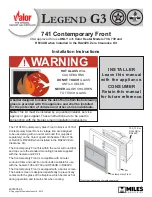
SA1F Time of Flight Laser Sensor
2
Buttons
Use the sensor buttons
Down
,
Up
,
Enter
, and
Escape
to program the sensor and to access sensor information.
Down and Up Buttons
Press
Down
and
Up
to:
•
Access the
Quick Mode
from
Run Mode
•
Navigate the menu systems
•
Change programming settings
•
Change individual digit values in distance based settings
When navigating the menu systems, the menu items loop.
Enter Button
Press
Enter
to:
•
Access the
Menu Mode
from
Run Mode
•
Access the submenus
•
Move right one digit in distance based settings
•
Save changes
In the
Menu Mode
, a check mark in the lower right corner of the display indicates that pressing
Enter
accesses a submenu.
Press
Enter
to save changes. New values flash rapidly and the sensor returns to the parent menu.
Escape Button
Press
Escape
to:
•
Leave the current menu and return to the parent menu
•
Return to
Run Mode
from the
Quick Mode
Note:
Pressing
Escape
discards any unsaved programming changes.
In the
Menu Mode
, a return arrow
in the upper left corner of the display indicates that pressing
Escape
returns to the parent
menu. Press and hold
Escape
for 2 seconds to return to
Run Mode
from any menu or remote teach.
Laser Description and Safety Information
CAUTION:
Use of controls or adjustments or performance of procedures other than those specified here in may result in
hazardous radiation exposure. Do not attempt to disassemble this sensor for repair. A defective unit must be returned
to the manufacturer.
Class 2 Laser Models
CAUTION: Never stare directly into the sensor lens.
Laser light can damage your eyes.
Avoid placing any mirror-like object in the beam. Never use a mirror as a retroreflective target.
Class 2 Lasers
Class 2 lasers are lasers that emit visible radiation in the wavelength range from 400 to 700 nm, where eye protection is normally
afforded by aversion responses, including the blink reflex. This reaction may be expected to provide adequate protection under
reasonably foreseeable conditions of operation, including the use of optical instruments for intrabeam viewing.
Class 2 Laser Safety Notes
Low-power lasers are, by definition, incapable of causing eye injury within the duration
of a blink (aversion response) of 0.25 seconds.
They also must emit only visible wavelengths (400 to 700 nm).
Therefore, an ocular hazard may exist only if individuals overcome their natural aversion
to bright light and stare directly into the laser beam.
Figure4. FDA warning label (Class2)
For Safe Laser Use - Class 2 Lasers
•
Do not stare at the laser.
•
Do not point the laser at a person’s eye.
•
Mount open laser beam paths is not at the eye level.
Reference IEC 60825-1:2007, Section 8.2
.




























